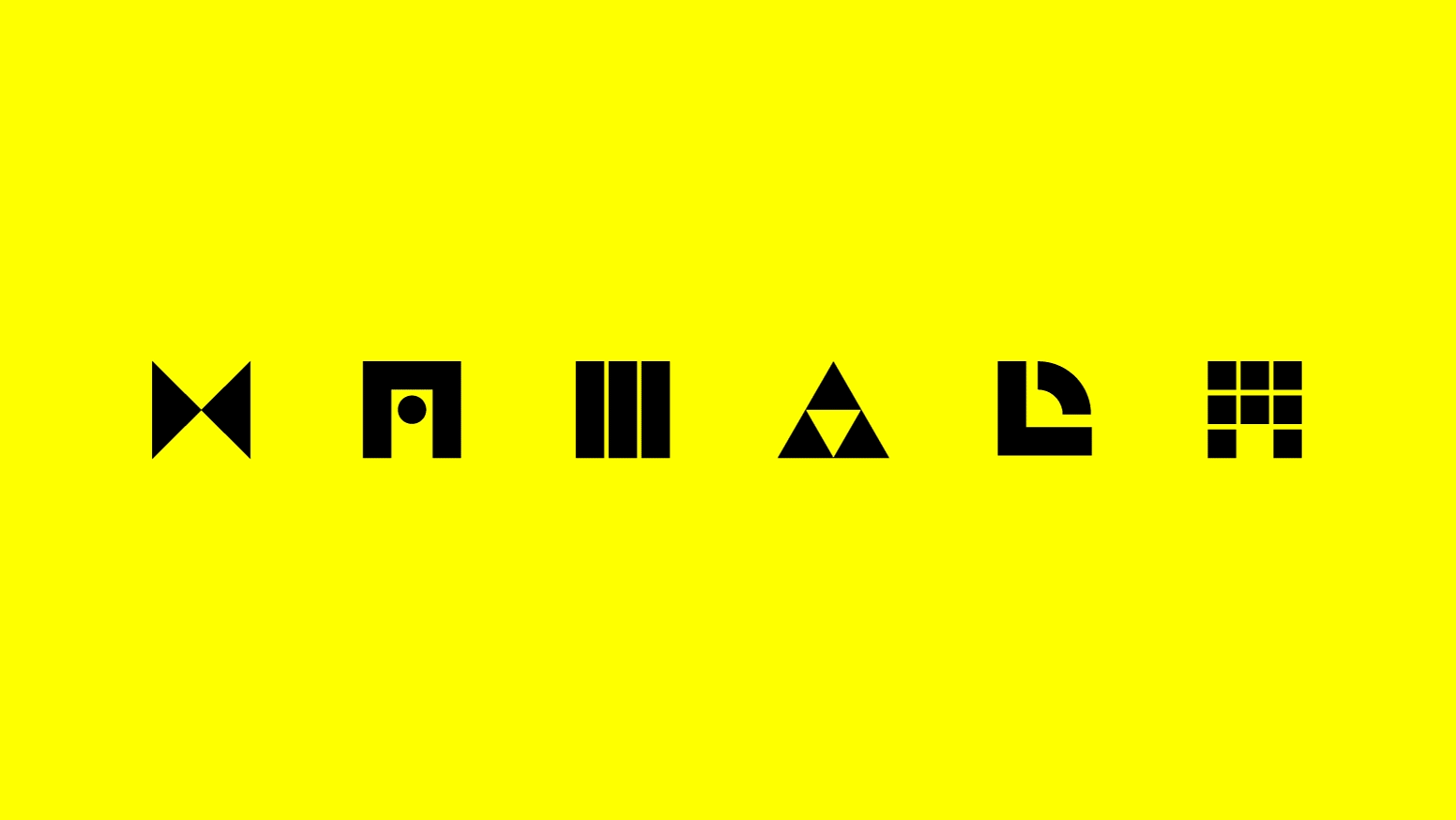Key Takeaways
- Privacy-Centric: Namada offers enhanced privacy features, including shielded asset pools and Shielded Data Availability, in collaboration with Cosmos, Celestia, and Zcash.
- Cross-Chain Interoperability: Focused on connecting Cosmos, Ethereum, and Zcash ecosystems through trustless bridges.
- Strong Partnerships: Namada’s strategic alliances with Celestia and Zcash highlight its emphasis on privacy innovation.
- Long-Term Growth: Challenges include Cosmos ecosystem size, but its privacy solutions position Namada for significant future adoption.
Also check out our previous blog posts, if you want to learn more about Namada:
- Namada (NAM): Privacy-Enabled Interchain Asset Connectivity Unboxed
- Namada (NAM): A Technical Deep Dive into Namada’s Modular Privacy Framework
Namada Ecosystem and Partnerships
First and foremost, Namada possesses a vast number of partnerships with a host of projects in the Cosmos ecosystem, most notably Celestia, Cosmos itself, and Osmosis. Essentially, Namada’s infrastructure is designed to allow any public Cosmos chain to make use of Namada’s privacy-preserving features in an arbitrary manner. This allows for various privacy formats for a host of uses, while providing the flexibility to adhere to the laws of different geographical regions.
Of major significance is Namada’s partnership with Celestia, an industry-renowned leader in modular blockchain development. The Celestia partnership is largely focused on the exploration of shielded data availability because of Namada’s privacy-focused shielded set architecture.
Within a privacy-enabled rollup running on Celestia users need to be able to submit transactions to Celestia without disclosing their identity. Although privacy-focused rollups do provide a degree of privacy, transparent fees that accompany transactions represent a challenge to ensure absolute privacy.
Through Namada’s Shielded Data Availability (DA) solution, users are able to generate their own zero-knowledge proofs on their own device, guiding a Namada validator set to submit their data to Celestia on their behalf. This masks the private data that could be representative of a single user or a larger group of users. By integrating features from both platforms (Namada’s privacy guarantees, with Celestia’s data availability) a stronger overall framework is established.
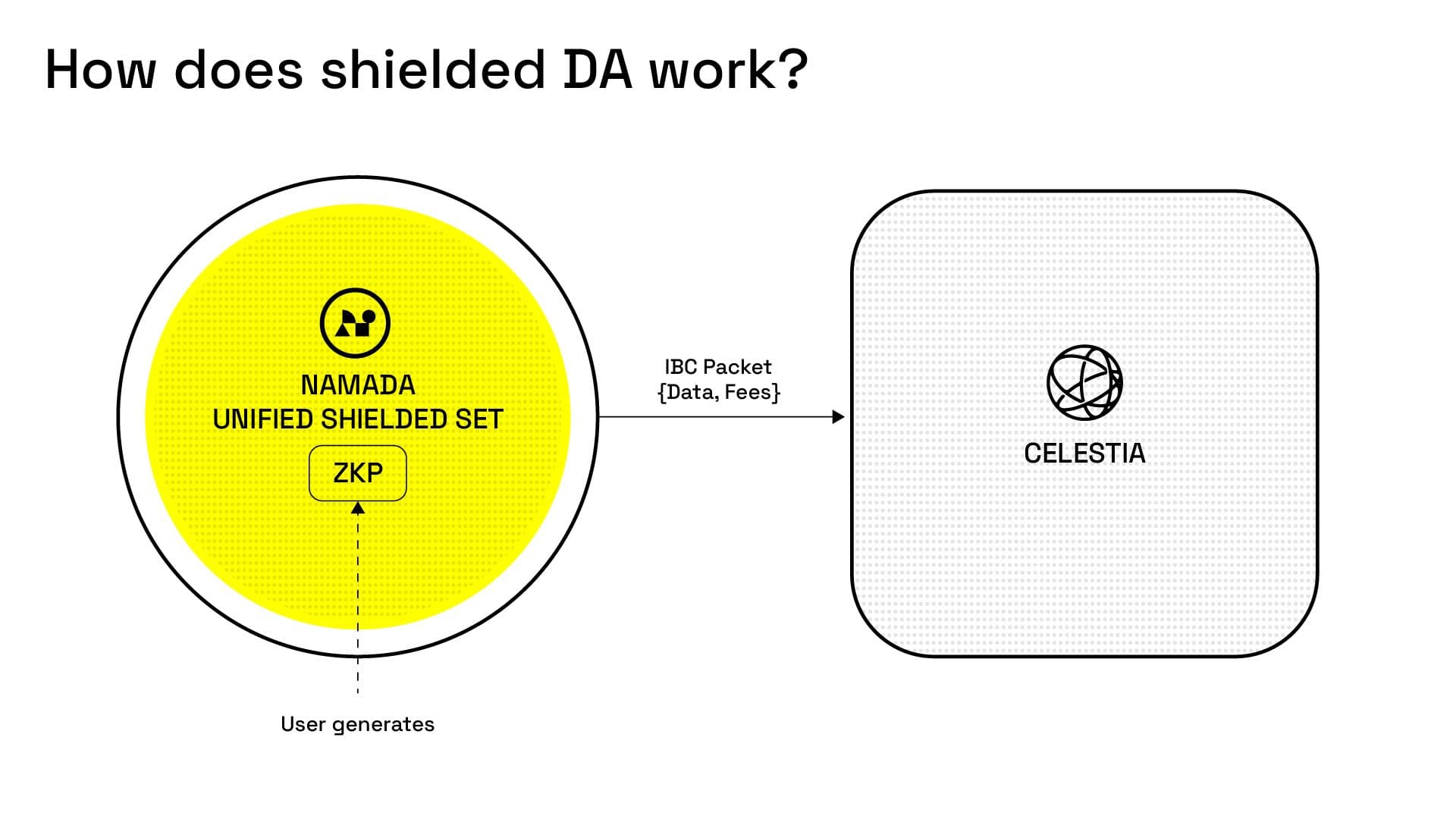
In April of 2023, Namada announced a strategic alliance with blockchain privacy pioneer Zcash, in part because Christopher Goes knew the founders of Zcash prior to joining Cosmos in 2017. The partnership will include three primary initiatives moving forward: first, a funding grant system that will fund projects building on both platforms; second, a NAM airdrop to both NAM and ZEC holders; and third, a plan to build a trust-minimized bridge between Zcash and Namada that will enable full interoperability between Namada, Cosmos, Zcash and Ethereum.
A month after the Zcash announcement, Namada initiated the first steps towards a partnership with Osmosis that will consists of three main parts:
- A NAM airdrop to OSMO holders, liquidity providers (LPs), and stakers who have supported Osmosis.
- The creation of a continued public good funding system which is allocated to grant pools managed by the Osmosis Grants Program to fund projects that jointly benefit the Namada and Osmosis ecosystems.
- The launch of a shielded asset exchange solution on the Osmosis DEX that allows users to benefit from the privacy-preserving features of Namada and the trading capabilities of Osmosis.
Ingeniously, the Namada shielded asset exchange solution allows Namada users to unshield OSMO tokens and transfer them to Osmosis, carry out a token swap to obtain ATOM, then transfer their newly acquired ATOM to the Cosmos Hub, and lastly to return them to Namada where they are reshielded, completing an extremely complex action in a matter of seconds.
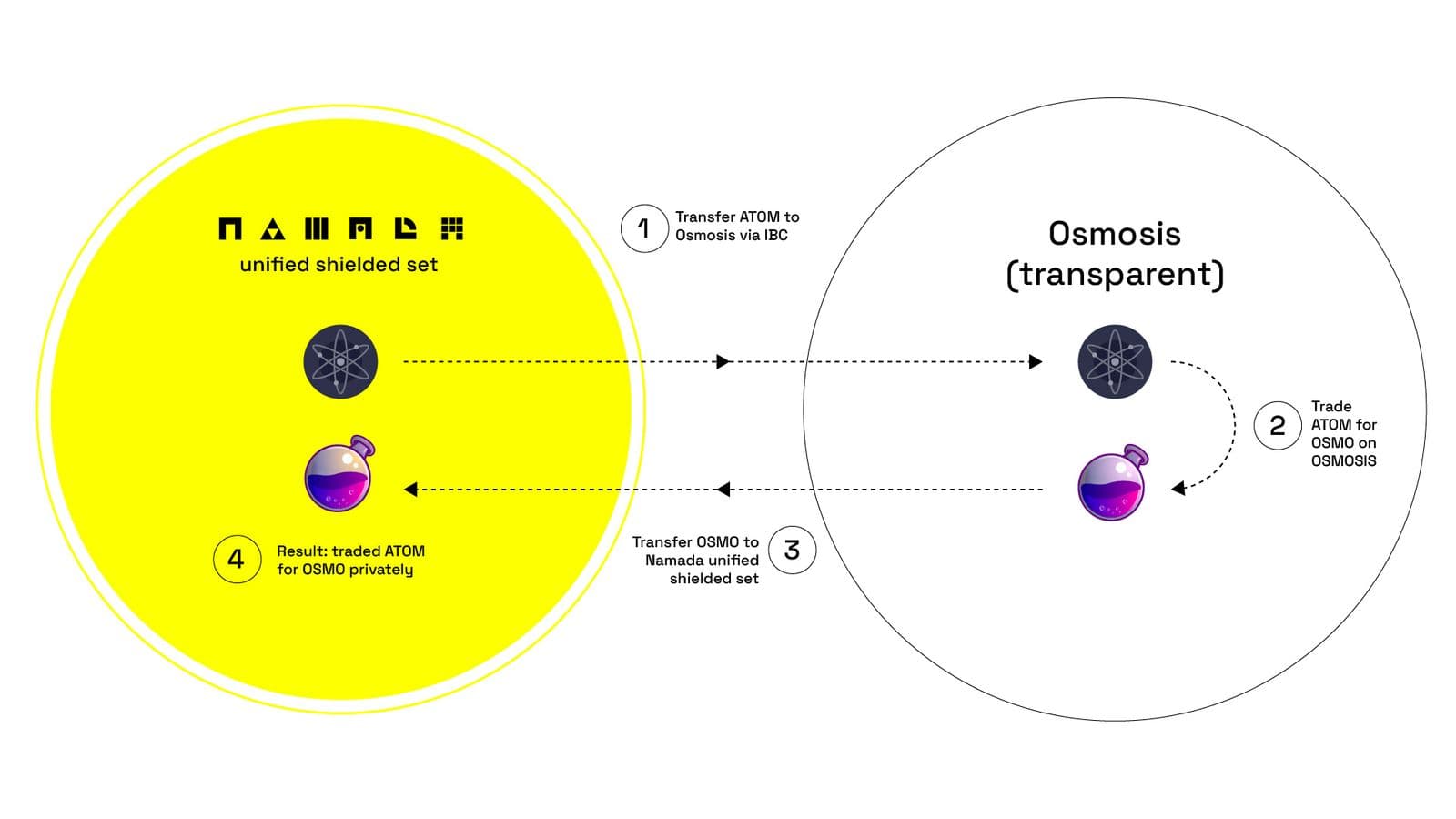
During December 2023, Namada also launched several newly created community expansion initiatives to support the ongoing growth of the project. These included the community builders program as a means to provide technical support, mentorship, and funding to ecosystem contributors via Anoma, Namada, and other Cosmos-ecosystem partners.
This initiative will go a long way to ensuring the long-term viability of the Namada ecosystem by helping software developers and other professionals deploy new products and services on the platform.
Namada Wallet Support
Namada recently developed its own wallet that offers both a web interface and browser extension to allow for seamless onboarding of users into the Namada ecosystem. The Namada wallet is built to be extremely secure and private and exhibits a strong user experience focused on simplified user interaction.
Namada also recently integrated Ledger hardware wallet connectivity into its desktop and browser extension wallet. This functionality allows users to connect the Namada wallet to Ledger to secure their assets while transacting within the proprietary wallet’s main interface.
Moreover, the Namada wallet allows users to interact with the platform on multiple levels, including for the operation of multi asset pools, as a means to send shieldied and transparent transactions on the network, and to enable accessibility to additional DeFi utilities on Cosmos and Namada.
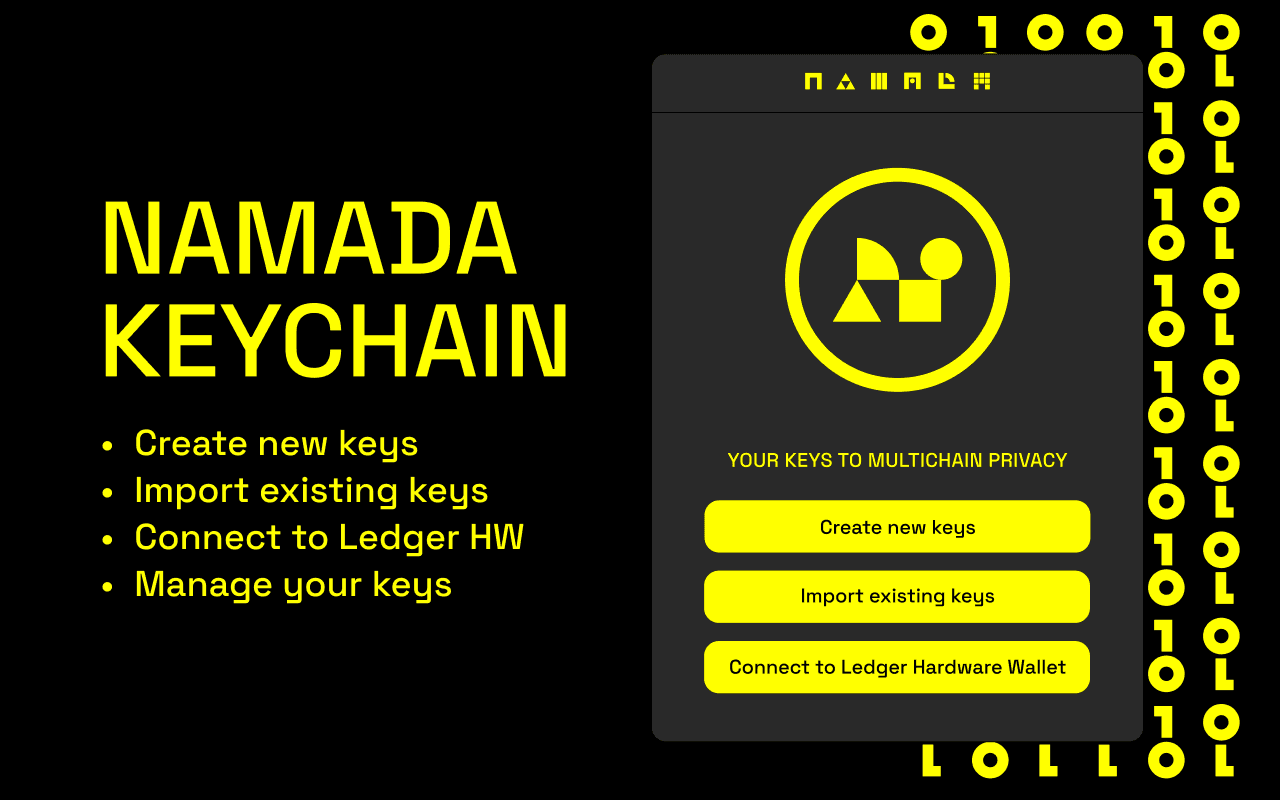
In addition, the Namada wallet provides a means for user-focused connectivity with the Keplr wallet (the main wallet built for the Cosmos ecosystem). This facilitates connectivity between Cosmos and IBC and all existing Cosmos ecosystem chains and their corresponding tokens.
Purchasing and Trading the Namada Token
Upon launch, the NAM governance and utility token will be available for purchase on a host of exchanges. Relatedly, it's important to provide a quick overview of how to purchase the NAM token on the Osmosis DEX because of its significance within the Cosmos ecosystem.
Purchasing NAM on Osmosis is quite simple. The first step is to create a Keplr Wallet and download the Keplr desktop browser extension. Next, it is necessary to purchase another Cosmos-ecosystem token (ATOM, TIA, or OSMO is recommended) on either a centralized or decentralized exchange.
After you have purchased the token you wish to exchange for NAM, it is necessary to send the token to the corresponding network address within your Keplr wallet. Once you have received your ATOM, TIA, or OSMO within Keplr, the next step is to connect your wallet to the Osmosis DEX, first by opening the Osmosis DEX launch page and then by opening the Keplr browser extension.
Finally, you’ll transfer the token you want to exchange for NAM to Osmosis, where you'll be able to swap that token for NAM. This is accomplished by selecting the asset you wish to exchange for NAM and selecting ‘swap.’ If you encounter issues during trade execution, try increasing the appropriate slippage threshold before you initiate your swap. Once successful, the final step is to transfer your recently purchased NAM from Osmosis to the Namada address within your Keplr wallet.

Namada Roadmap and Future Initiatives
Namada Past Milestones
- December 2020 - Anoma Foundation is founded
- May 2020 - the Namada project is founded
- Fall 2022 - first version of the Namada testnet goes live
- December 2022 - Namada’s main public testnet goes live
- February 2023 - completion of the Namada-Ethereum bridge is announced
- April 2023 - Zcash strategic alliance is announced
- May 2023 - Namada economic and governance frameworks are announced
- May 2023 - Osmosis partnership is announced
- August 2023 - shielded swaps go live on Osmosis
- September 2023 - Celestia partnership is announced
- October 2023 - Anoma announces 10 million NAM tokens will be allocated to the first RPGF community builders program
- December 2023 - Namada RPGF program announces the allocation of 6.5% of the total supply to ecosystem contributors
- December 2024 - Namada mainnet goes live
In 2024, Namada will focus on the enhancement of several in-house protocol improvements as well as the continued development of partnerships with numerous blockchain ecosystems. This will include continued expansion with the Cosmos, Ethereum, Zcash, and Celestia ecosystems.
Relatedly, expanding cross-chain interoperability to other ecosystems will be a significant focus for Namada in 2024. This will largely be realized through the development of new cross-chain asset bridges that connect Namada to other blockchains. The first step for this to come to fruition is to build several transparent bridges, and later, to transition these bridges to become fully private.
Without these all-important privacy-focused upgrades, users will lose privacy when sending assets between Namada and other private chains. Therefore, the long-term goal is to connect all newly developed bridges together so they share a larger interconnected privacy set.
Another change that will be integrated into the protocol stack in the near-term is the introduction of the Halo2 circuit (which, like the Sapling Circuit, is developed by Zcash), which will allow for the removal of the trusted setup, paving the way for greater system security, enhanced scalability, an improved developer experience, and a host of additional improvements.
Namada Comparative Privacy Analysis
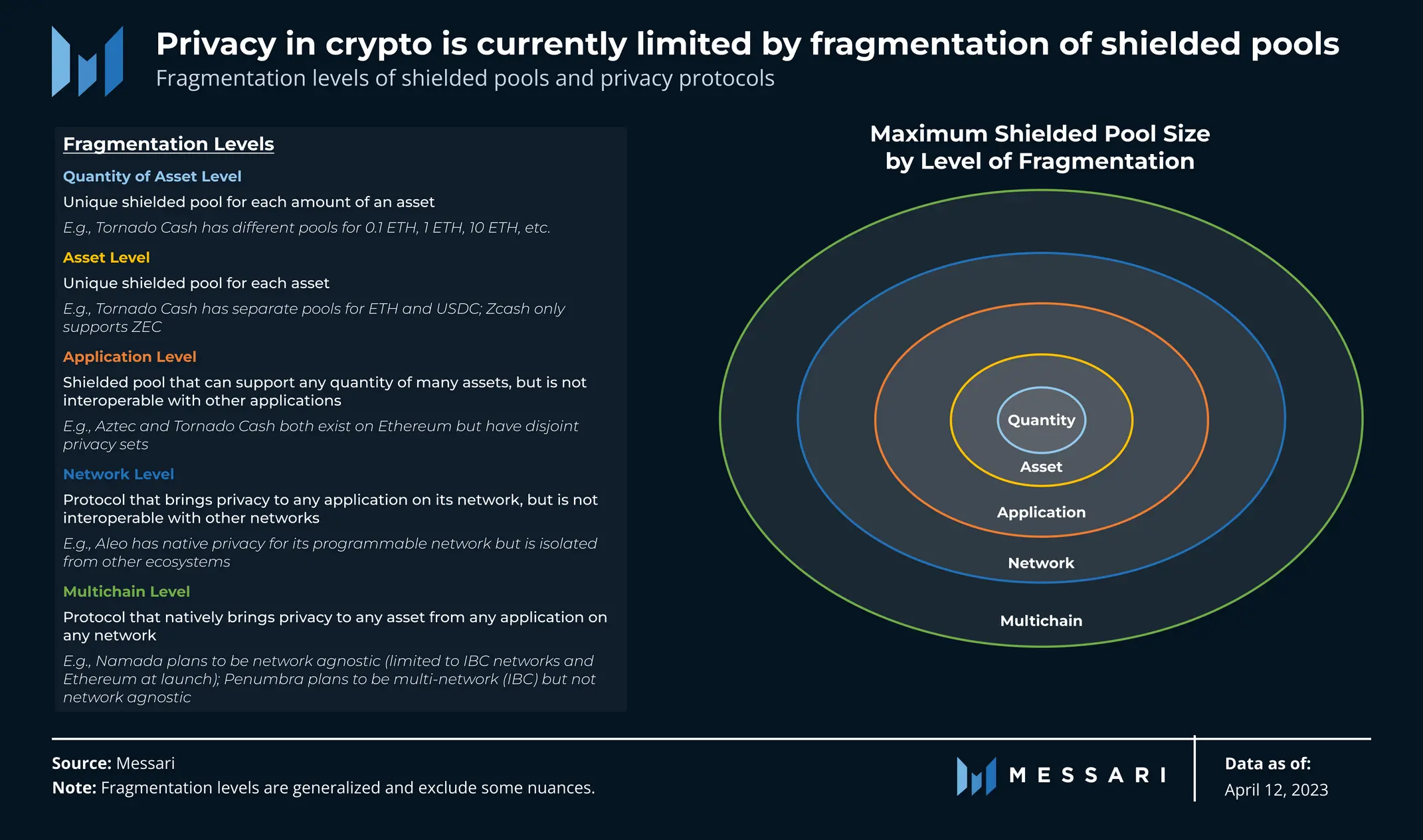
According to Namada co-founder Awa Sun Yin, blockchain privacy sets suffer from fragmentation at three main levels. These include:
- Asset level: Asset level fragmentation limits the sharing of different types of tokenized assets between separate liquidity pools, highlighting limited asset interoperability.
- Application level: Fragmentation at the application level means that privacy-preserving protocols within the same ecosystem (e.g., Aztec and Tornado Cash on Ethereum) exhibit detached privacy sets.
- Network level: The lack of asset interoperability at the network level means that Layer 1 blockchains are unable to share assets between different ecosystems because of their isolation from other networks.
Let’s introduce four privacy-focused blockchains and touch on their issues at these levels:
Zcash
Originally a Proof of Work (PoW) fork of Bitcoin, Zcash became a pioneering privacy-focused blockchain upon its release in October 2016. Zcash was one of the first blockchains to introduce zero-knowledge proofs using zk-SNARKs. Zk-SNARKs allow one party (the prover) to verify to another party (the verifier) that specific data is true without revealing additional sensitive data.
This capability was realized through a secure multi-party computation (MPC) framework called a Trusted Setup (which was eventually removed from the protocol). Zcash makes use of two main address types: z-addresses (private addresses) and t-addresses (transparent addresses). Z-address technology was later improved with the introduction of the Sapling Circuit in October 2018 (which Namada enhanced via the MASP and CC circuits).
Unfortunately, scripted settlement Layer 1’s like Zcash are not programmable. This means they are fragmented at the asset level (privacy usage is limited to a single asset (e.g., ZEC)) and the network level because of limited interoperability.
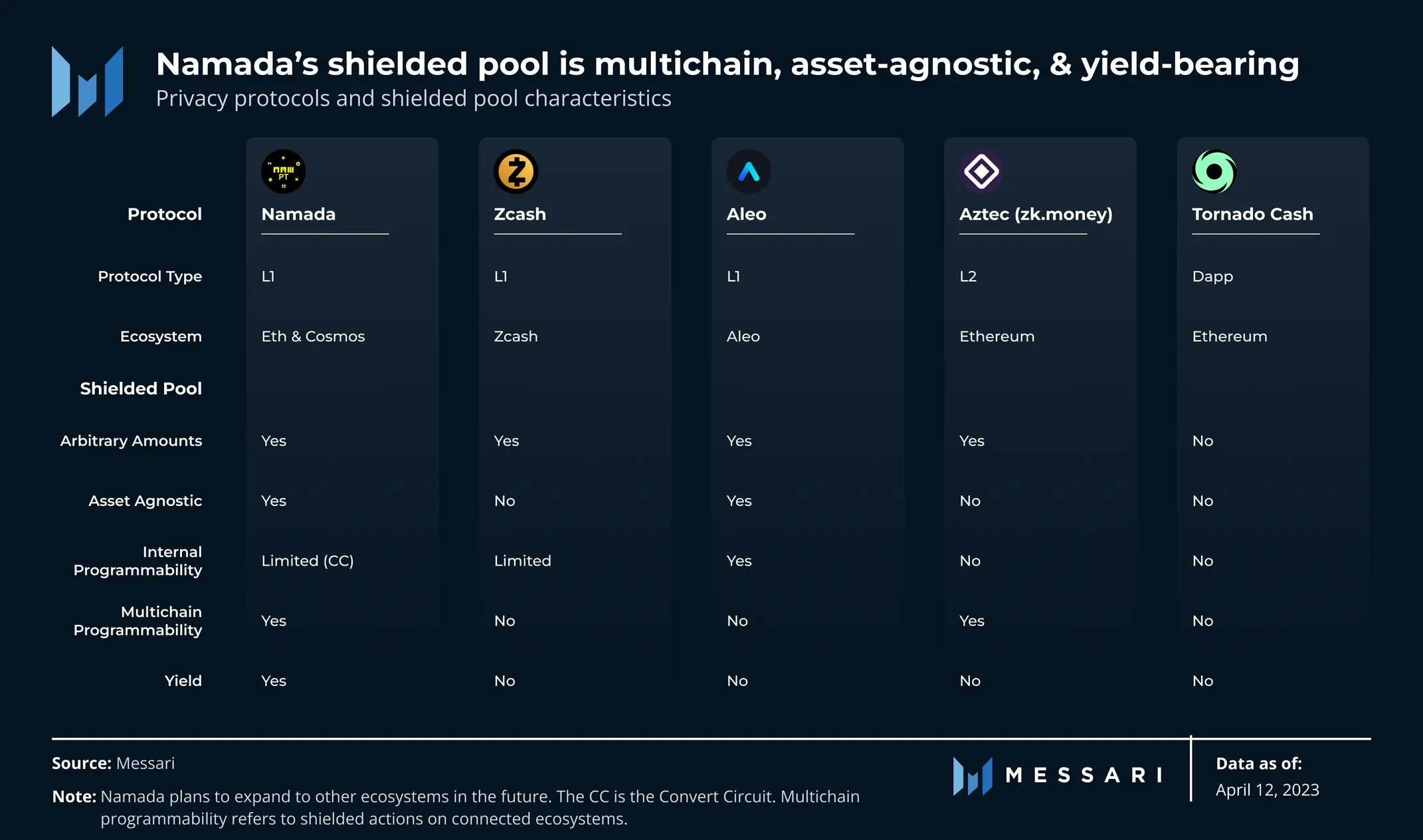
Tornado Cash
Tornado Cash is an open source, decentralized, non-custodial application that runs on Ethereum, operating as a cryptocurrency tumbler that mixes cryptocurrency transfers to obfuscate their true source (to essentially mask the sender’s identity).
Privacy application Tornado Cash exhibits fragmentation at the assets level because it makes use of separate shielded pools using ERC-20 tokens (such as ETH and DAI) and is only able to achieve privacy using Zcash. Tornado Cash is also fragmented at the asset quantity level because its shielded pools offer pools for different asset quantities (e.g., 0.1 ETH, 1 ETH, and 10 ETH).
Aztec
Aztec is a programmable Layer 2 settlement layer that allows shielded actions to interact with Ethereum. The Aztec protocol also employs privacy-preserving zk-Rollups and has been lauded by the founders of the project as “an encrypted version of Ethereum.” Regardless, Aztec represents a unique blockchain privacy solution.
Unlike Layer 1 protocols that must bootstrap their own liquidity, Aztec’s user base is made up of users within the Ethereum ecosystem. However, the Aztec protocol is fragmented at the network and application levels because the protocol is not native to the core Layer 1 network (Ethereum).
Aleo
Aleo is a programmable Layer 1 blockchain that makes use of smart contracts, arbitrary computation, and zero-knowledge proofs. The Aleo project leverages a zero-knowledge virtual machine (snarkVM) and its own privacy-focused operating system (snarkOS) that combine to provide a zero-knowledge cloud platform.
Aleo — and similar Layer 1’s like Cosmos’ Secret Network — provision privacy and arbitrary computation within their protocols, allowing for DeFi, governance, and other applications that benefit from privacy, provided they are built within the same network. Despite Aleo’s innovations, the platform suffers from fragmentation at the network level because of its lack of cross-chain interoperability.

Find out more about Aleo in our blog post: Aleo (ALEO): A Privacy-Focused ZK Cloud Computation Network
Namada: A Cutting-Edge Solution in a Competitive Privacy Landscape
Namada’s pioneering privacy-centric unification between the Unified Shielded Set (USS) and Shielded Actions (SA) represents a privacy framework that solves fragmentation at the asset, application, and network levels.
Firstly, at the asset level, Namada’s shielded pools allow for the exchange of assets between one another through the Unified Shield Set, solving the challenges that protocols like Tornado Cash encounter on Ethereum.
Secondly, at the application level, Namada allows for the transfer of assets between IBC-chain wallets within the Cosmos ecosystem, eliminating the problems that privacy-focused platforms face when they are confined to the same ecosystem.
Finally, at the network level, the Namada protocol allows for the sharing of assets within the Cosmos ecosystem, while Namada’s trustless Ethereum bridge allows for the sharing of assets with Ethereum. In time, the team behind Namada will build bridges to connect Cosmos and Namada to additional blockchain ecosystems, further eliminating asset fragmentation at the network level.
Examining Namada’s Long-Term Potential
The long-term potential of Namada is extremely strong but the project does face some challenges. One of the main issues with Namada and all IBC chains is the fact that the Cosmos ecosystem is quite small when compared to larger ecosystems like Ethereum, Binance, Avalanche, Solana, and others.
This could represent a challenge in terms of adoption and overall liquidity accrual within the ecosystem. Conversely, this issue also could represent a potential opportunity because strong growth is expected within the Cosmos ecosystem moving forward.
Another disadvantage for Namada is the fact that the protocol just launched, meaning it could take some time to gain significant market traction. However, this could also be a positive because newer projects are often significantly more hyped when compared to their older counterparts. That said, because of Namada’s complex privacy-preserving design and the new utility it provides for private DeFi and other uses, the project could be susceptible to challenging regulatory issues.
Regardless, Namada’s modular intent-centric design should be considered state-of-the-art in industry terms and represents a newfound archetype for 3rd-generation privacy-preserving blockchains. Namada’s relationship with several industry leaders — especially Celestia, Zcash, Osmosis, and the greater Cosmos ecosystem — will go a long way in fostering its adoption over the next several years.
In summary, Namada is an exceptionally innovative project with a strong foundational design that gives it the potential to be a leader in the blockchain privacy niche moving forward. The team behind Namada is next-level and the architecture combining the Unified Shield Set and Shielded Actions is a game-changer compared to current blockchain privacy offerings.
All things considered, Namada’s vision for privacy as a programmable public good cannot be understated. The platform is representative of a potentially groundbreaking privacy solution and the project has a good chance to achieve widespread adoption long term.
Resources
The information provided by DAIC, including but not limited to research, analysis, data, or other content, is offered solely for informational purposes and does not constitute investment advice, financial advice, trading advice, or any other type of advice. DAIC does not recommend the purchase, sale, or holding of any cryptocurrency or other investment.
